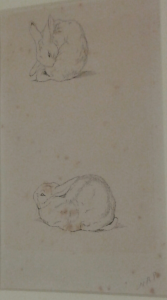The significance of Beatrix Potter’s work, “Two Bunnies”, a Christmas card, was that Potter’s first published work was greeting cards. In the Potter household, Christmas was “acknowledged rather than celebrated (Jacklin 1)”. Potter enjoyed making Christmas cards for family, and was encouraged by her uncle to get them published. Much of her inspiration for these cards came from her pet rabbit Benjamin Bouncer. At twenty-three, she sent out her cards to commercial publishers. The second publisher that Potter went to ended up being her big break into the illustrative world. While Hildesheimer and Faulkner liked her greeting cards, even sending her a check for 6 pounds, they thought she was a male designer. When she met Faulkner he was pretty “civil” but rather “dry”, and not even complimenting her cards while demanding a more of them. Hildesheimer and Faulkner published her work but Potter never liked the cards since they lost much of their color because they were produced using chromolithography. She decided to use the three color process which she was making her first book The Tale of Peter Rabbit (Jacklin 1). The three color process is a process by which natural colors are replicated by combining photos to form the three primary colors (Three-Color Process 1). It retained much of her subtle water color work. Potter’s greeting cards allowed her to enter the publishing world for the first time, though she mostly stopped doing greeting cards until later in her career (Jacklin 1).
Historically, up until the beginning of nineteenth century, people didn’t celebrate Christmas. Many businesses didn’t consider it a holiday. The celebration of Christmas was thought to have started because of Queen Victoria and Prince Albert. In 1848 The Illustrated London news published a picture of Victoria and Albert around a Christmas tree, and soon it was the hottest trend. Everyone started having a tree (Victorian Christmas – History of Christmas 1).
As for the start of the Christmas card, it started with Henry Cole. Henry Cole, a very rich man in Victorian England, realized he was getting piles and piles of letters from his friends/acquaintances during Christmas/New Year, and realized he needed to respond to all of them, as it was very rude to not answer mail in Victorian times.
Cole commissioned his artist friend J.C. Horsley to design a Christmas card with his ideas. One idea included a family around table flanked by images of people helping the poor. Once done, he had a thousand copies made by a London printer, with the template “TO:_______” which would give Cole the ability to make each response special included with a generic Christmas greeting. Some of these cards featured children sharing wine with adults on them, so critics believed he was encouraging underage drinking. That, however, did not stop people from buying cards (Hanc 1).
Many children, including queen Victoria’s were encouraged to make their own Christmas cards. Because of the industrial revolution, color printing became much more advanced, so the price dropped. That, combined with the half-penny postage rate, the Card industry became quite successful, and by the 1880s people sent a lot of Christmas cards (11.5 million in 1880 alone) (Victorian Christmas – History of Christmas 1).
The piece itself, “Two Bunnies”, is a picture of two bunnies, and is in good condition, with minor foxing marks on it. Foxing is small, yellow or brown spots on the paper. Two main causes for foxing is mold or iron contaminants in the paper. The fur is very detailed, like most of Potter’s work concerning animals (Potter 1). The line weight also varies in the drawing. As with her other works, she signed it “HBP (1)”. The piece resides in the Mark Samuels Lasner Collection at the University of Delaware.






